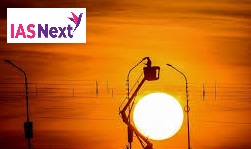CURRENT AFFAIRS
Get the most updated and recent current affair content on Padhaikaro.com
What is Green Energy Corridor (GEC)?
- IAS NEXT, Lucknow
- 10, Jan 2022

Reference News:-
The Cabinet Committee on Economic Affairs has approved the scheme on Green Energy Corridor (GEC) Phase-II for Intra-State Transmission System (InSTS).
What is the Green Energy Corridor Project for Intra-State Transmission System (InSTS)?
The Green Energy Corridor(GEC) Project aims at synchronizing electricity produced from
renewable sources such as solar and wind with conventional power stations in the grid.
Phase I of the Project:
It is being implemented by eight renewable-rich states of Tamil Nadu, Rajasthan, Karnataka, Andhra Pradesh, Maharashtra, Gujarat, Himachal Pradesh, and Madhya Pradesh.
Under this phase, the target is to install 9700 circuit km of transmission lines and 22,600 MegaVolt-Amperes(MVA) transformation capacity of substations by 2022.
The funding mechanism consists of a 40% Government of India Grant, 20% state equity and a 40% loan from KfW Bank, Germany.
Phase II of the Project:
It is being implemented in seven States namely, Gujarat, Himachal Pradesh, Karnataka, Kerala, Rajasthan, Tamil Nadu and Uttar Pradesh.
Under this phase, the target is to install 10,750 circuit km of transmission lines and 27,500 MegaVolt-Amperes(MVA) transformation capacity of substations by 2025-26.
The Centre will provide assistance at 33% of the cost of the project.
Need for a Green Energy Corridor in India:
- Prime Minister has pledged to increase the country’s non-fossil fuel power generation capacity to 500GW and meet 50% of its energy requirements from renewable sources by the end of this decade. So there is a need for integration.
- The scheme will help in achieving the target of 450 GW installed RE capacity by 2030.
- It will also contribute to long-term energy security of the country and promote ecologically sustainable growth by reducing the carbon footprint.
- It will generate large direct and indirect employment opportunities for both skilled and unskilled personnel in power and other related sectors.
- The GEC will help in offsetting the intra-state transmission charges and keep the power costs down. Thus, the government support will ultimately benefit the end users.
- It helps India to increase the share of non-fossil fuels-based electricity to 40% by 2030.
- The project is expected to help India meet the climate commitments it made at the COP-26 summit in Glasgow.